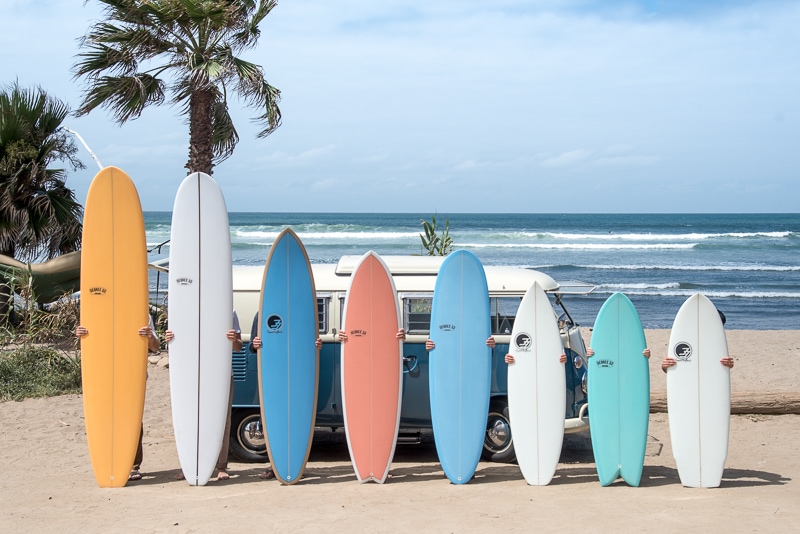
You’ll never forget your first surfboard. Mine was a 6’6” pintail JC Hawaii hand-me-down with glassed in fins and an awful yellow sunburn. Little did I know, this is far from the ideal beginner surfboard. At the time, it was the kind of board that a pro surfer would ride at a solid barreling wave like Banzai Pipeline. AKA, perhaps one of the worst surfboards to learn to surf on.
I didn’t know any better and I remember just being super stoked to finally have my very own surfboard. So I went on my merry way, on a paper-thin, potato chip pro model surfboard, struggling to claw into waves, falling nonstop because of the lack of stability, and getting super frustrated with how long it was taking to learn how to ride a wave.
Needless to say, it was a slow and challenging progression and I could have really used some guidance at the time. Fortunately for you, I’ve already made some bad surfboard decisions throughout my surfing journey so you don’t have to.
Selecting the right board for your surfing level can be the difference between having a blast and a world of frustration. Let’s avoid that world of frustration, shall we?
In this article, I’ll cover the best beginner surfboards, how to gradually make the transition from a longboard surfboard to a shortboard surfboard, and give you some recommendations for boards at every level.
With some basic board knowledge under your belt, you can be confident you’re buying the right surfboard for your level and exponentially increase your learning curve and fun factor.

The Best Beginner Surfboards
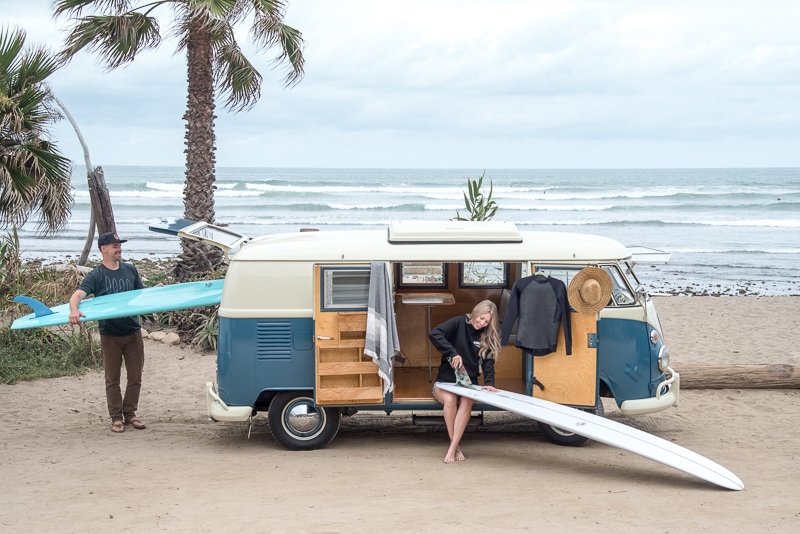
What makes a good beginner surfboard? When you’re learning how to surf, there are a few fundamental skills you’ll want to work on and develop before progressing to the next level. Most notably: where to position yourself on the board, your pop-ups, balance, paddle strength, endurance, and so on.
With these basic skills in mind, a good beginner surfboard is easy to paddle, floats you well (high buoyancy), and is very stable. The basic rule of thumb here is: the bigger the better.
The best beginner surfboard makes it as easy as possible to catch and ride as many waves as possible. Because the more waves you catch, the quicker you’ll progress. With a wide and stable outline and lots of buoyancy, a longboard surfboard is the best beginner surfboard around.
In the following sections, we’ll go into more detail and also give recommendations for specific surfboards.
Considering everything that makes a good beginner surfboard, all of the opposite points are true for what makes a bad beginner surfboard. If you try to learn or progress on a board that’s too small for your current surfing ability, you’re setting yourself up for a challenging time. Smaller boards don’t float you well and have less stability, making it much more difficult to paddle, catch waves, pop up, and balance.
Here’s a quick summary with minimal surfboard jargon:
The Best Beginner Surfboards:
- Are longer surfboards with plenty of stability
- Have a fuller shape (which will provide more stability)
- Have lots of volume that will float you well (the board is on the thicker side)
- Are easy to paddle and catch waves
The Worst Surfboards for Beginners:
- Are short surfboards that don’t give much stability
- Have a narrow shape
- Have low volume (essentially this means a thinner and lighter board)
- Are difficult to paddle and catch waves
Surfboard Construction
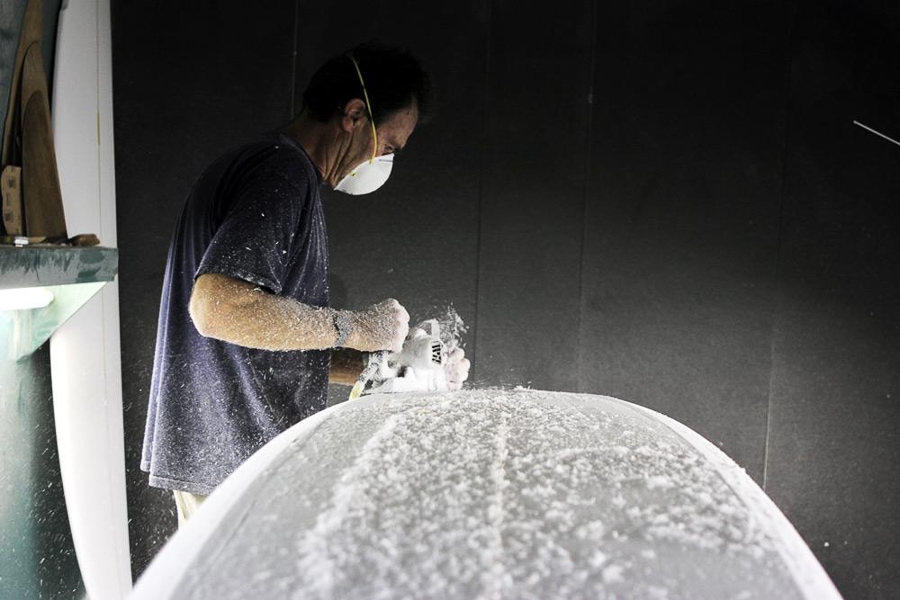
Another element to consider in your board search is surfboard construction (i.e. what your surfboard is made of). There a lot of different materials being used to make surfboards these days, but we’ll keep this high level. Two of the most common surfboard constructions are Polyurethane (poly or PU) and Epoxy.
Epoxy surfboards are very popular with beginner surfers because they are known to be much more durable and buoyant than traditional poly surfboards. Epoxy boards don’t get dinged as easily, they float really great, and they’re very easy to paddle.
Poly boards are typically not quite as buoyant and are a little bit heavier, but they have more flex to them which becomes more relevant and is a common point of preference for more advanced surfers. Poly boards are going to be more susceptible to dings and damage, so you’ll need to be more careful with transporting and handling your board.
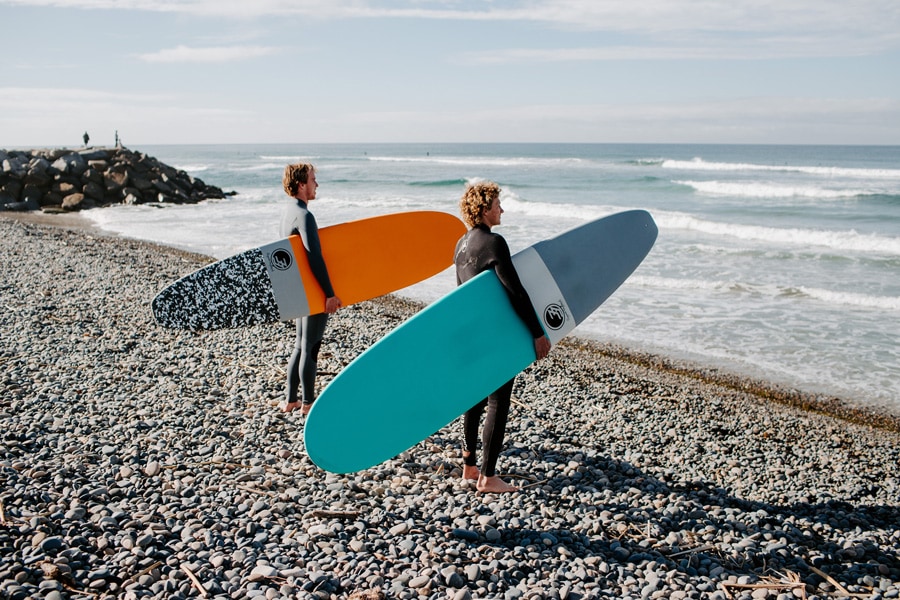
Another popular type of surfboard for beginners is a soft top surfboard, also known as a foamie. Soft top surfboards are exactly as they sound – they have a soft, dentable/durable top layer as opposed to a typical surfboard with a hard fiberglass top layer.
Soft top surfboards are a good option for beginner surfers because they’re user-friendly, very stable, and easy to paddle.
When you’re learning how to surf, falling is an unavoidable part of the process and it’s likely that you’ll bump into your surfboard here and there along the way. With a soft top surfboard, these bumps will be, well, softer than a poly or epoxy board. Lastly, soft tops are extremely durable so you don’t have to worry about dings or damage.
What type of surfboard construction is best for beginners?
Like most things, it really depends on your personal preference and surf progression. You might want to just rent a soft top board as you start to learn in the beginning and save your money to buy a poly or epoxy longboard soon after. Or perhaps you want to buy a soft top and stay surfing it for quite a while before transitioning to a hard top board.
If you’re privy to crashing into things, you might want to get a soft top or epoxy board that’s more durable to withstand your abuse (instead of a poly board that can get dinged more easily). If you have specific questions, feel free to ask in the comment section at the bottom of this article and we’ll give you some feedback!
The Progression of Learning to Surf
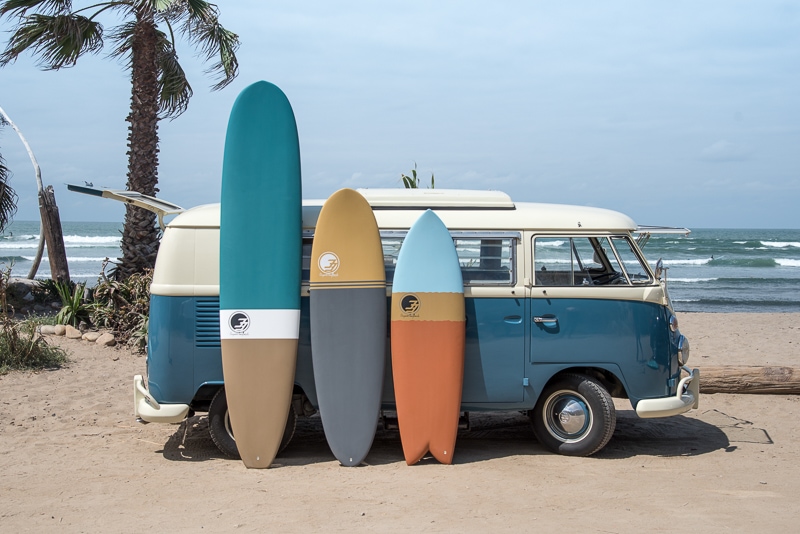
Different strokes for different folks. Maybe you’re the casual and stylish lifelong longboarding type or your surf ambitions are simply to be able to cruise down the face of a wave without eating it, nothing wrong with that.
But it’s probably fair to say that when most people first get interested in surfing, they’re looking at the ocean watching a good surfer rip a wave to pieces, or seeing a pro make unbelievable maneuvers in a surf film and they’re thinking, “I want to surf like that!”
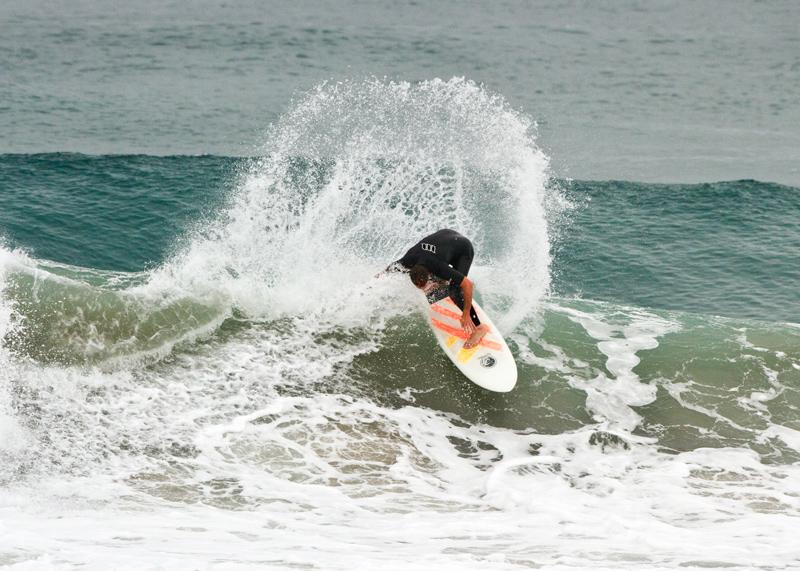
For the majority of us normal humans, that level of surfing might be a long stretch. But don’t be discouraged because it doesn’t make surfing any less fun. The constant progression and breakthroughs of your own surfing ability are always so fun and exciting you’ll never even know the difference.
And hey, who am I to say you won’t be the next Kelly Slater in just a few short years of testing the waters. Our only limitations are the ones we impose on ourselves, right?!
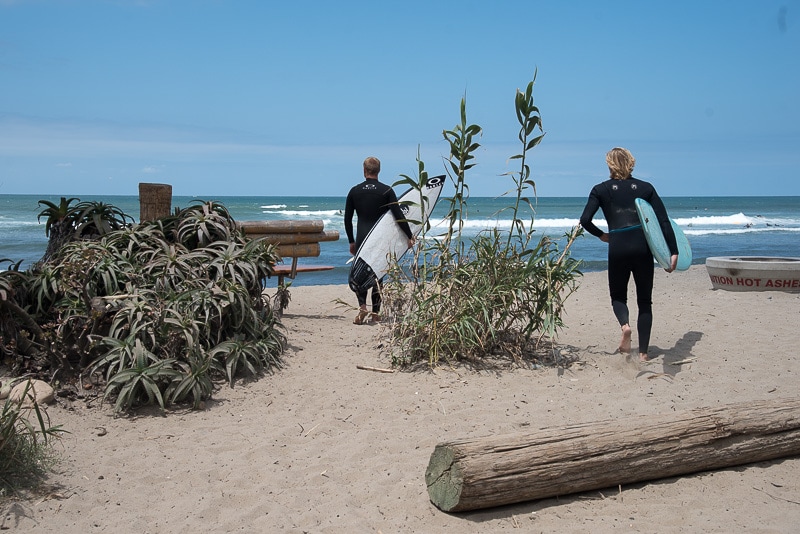
One thing is for sure, if you want to get as good as possible as fast as possible, you’re going to need all the help you can get and there are a few shortcuts you can take along the way to make your own progression smooth and seamless.
One of those shortcuts is being on the right board at the right time for your surfing ability and gradually downsizing in board length once you master the necessary skills for the board you’re on.
Here’s the ideal progression path to most quickly take your surfing skills from beginner to advanced, and how to transition from a longboard to a shortboard.
The Longboard Surfboard – Step 1
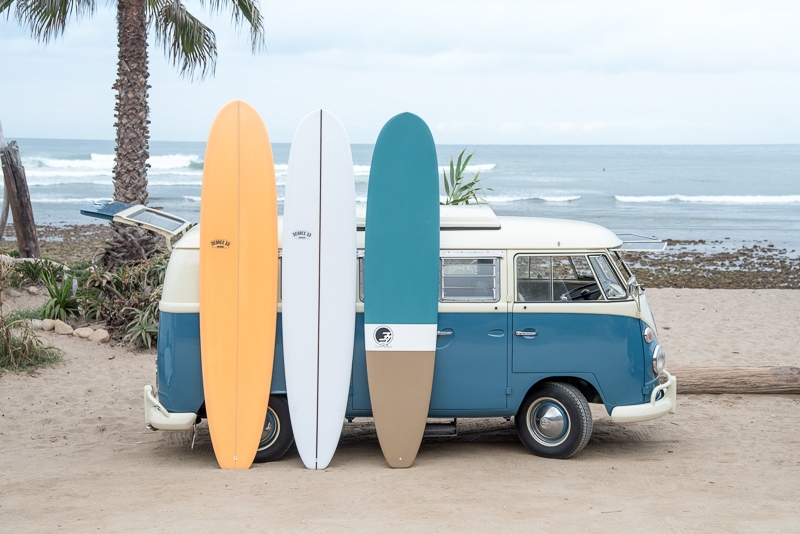
When I was learning to surf, it seemed that anything over 8 feet with a longboard outline (basically a wide template with a full and round nose) would qualify as a longboard.
Nowadays, surfboard shapes and designs are constantly being debated and broken down further and further into smaller more specific categories. So a lot of surfers might call an 8’ surfboard with a full outline a mid-length and might tell you that longboards aren’t really longboards until they’re 9’ or longer.
Alas, let’s spare the technicalities and details of what makes a surfboard a mid-length or a longboard for another article and for the sake of this article call anything with a longboard outline above 8’ a longboard. Sound good? Great. Glad we’re on the same page.
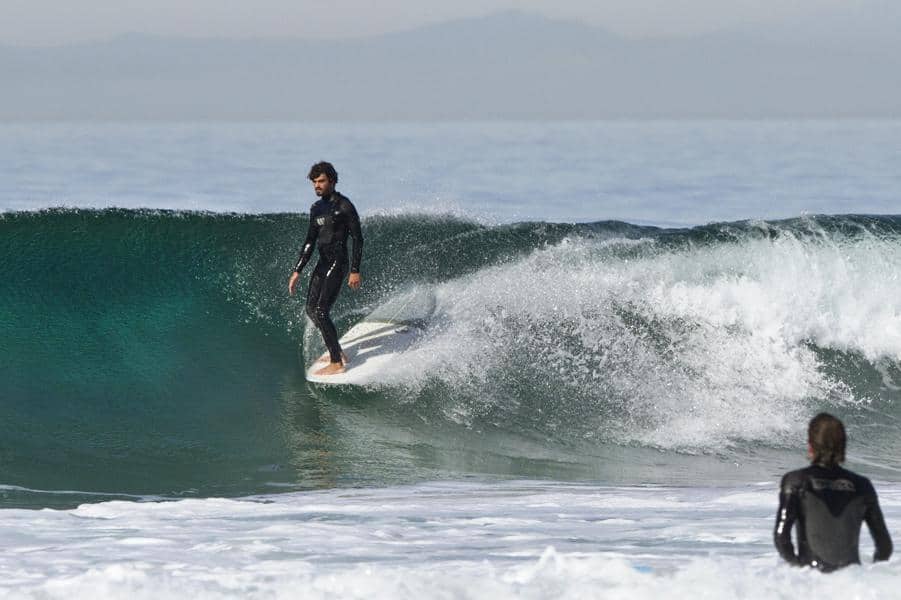
Once again, longboard surfboards are prime beginner surfboards, even if your ultimate goal is to shortboard. While longboards come in a variety of lengths and dimensions, they are typically wide, flat, stable, thick, buoyant, and very user-friendly.
A good rule of thumb is to start with a longboard that is about 3’ longer than your height. So if you’re 5’8” to 6’0” tall, a 8’6” to 9’0” longboard would probably be a good place to start.
Top reasons why longboards are the best beginner surfboards:
- It’s easier to catch waves so you’ll spend more time actually riding waves and less time bobbing around in the ocean waiting for a strong enough wave to catch.
- Longboards offer the most stability, making it much easier to pop up and balance on your board.
- You’ll be able to paddle back out to the break much faster and easier, increasing your wave count and sparing your energy.
- You’ll be able to surf on super small and fun days, which are ideal for learning anyways and often not surfable for shortboarders.
- As you learn the fundamentals of flowing with the wave and maneuvering a longboard, it’ll make your shortboarding style and ability that much cleaner and more refined when you get there.
- All of the above reasons will enable you to catch more waves, which means you’ll surf more waves, which means you’ll get more experience and ultimately improve your surfing as quickly as possible.
Recommended Longboards for Beginners:
The Funboard Surfboard – Step 2
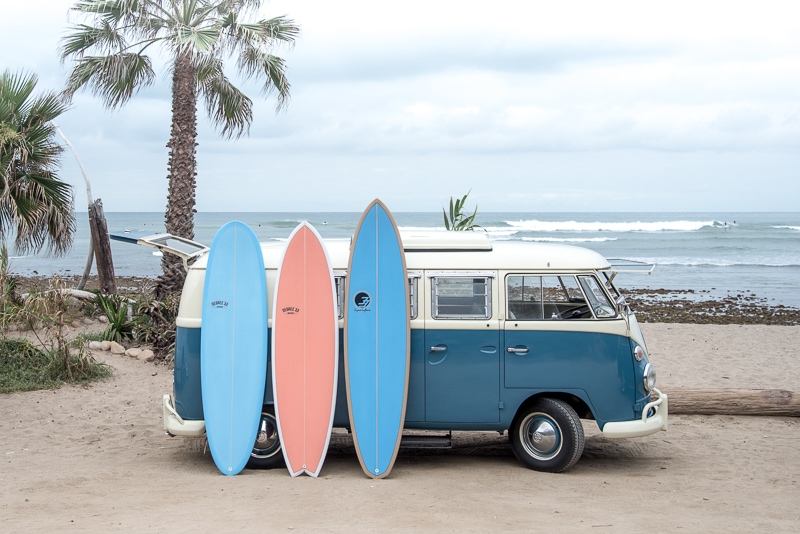
Once you’ve started to grasp some of the fundamentals of surfing, you’ll be stepping into the advanced beginner or intermediate realm and ready for a shorter board. Enter the funboard.
Funboards are surfboards that are around 6’ to 8’ long with a wide round shape and forgiving rails. Funboards come in all sorts of shapes and sizes, from 6’ mini-eggs to 7’ hybrid fish surfboard shapes and more.
Again, there are a lot of different terms for specific shapes like an egg or a fish and some general terms can often be used interchangeably like funboard, mid-length, or hybrid, but let’s keep it simple and call anything with a fuller outline in the 6’ to 8’ range a funboard.
The features of a funboard make it a perfect stepping stone on the path to progressing from a longboard to a shortboard. With wide outlines, fuller rails, and still plenty of buoyancy, you’ll be feeling super nimble and snappy on your more compact funboard, without sacrificing wave count.
At this step in your progression, you’ll really want to explore the maneuverability of the shorter more responsive surfboard. You’ll want to work on pumping down the line to generate more speed, surfing the wave from top to bottom, and your execution of open face turns and cutbacks.
Recommended Funboards for Beginners:
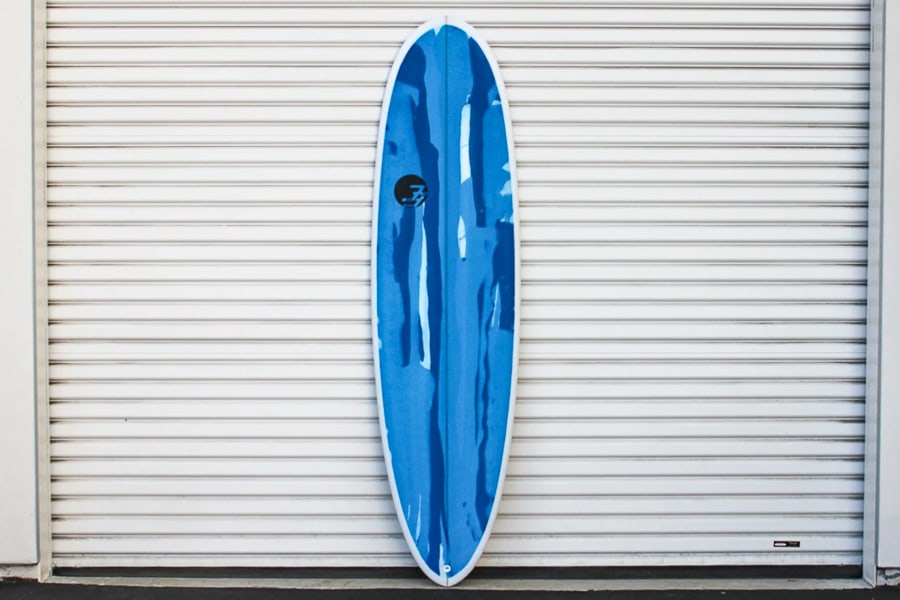
The Poacher / Mid-length Funboard
- Available 6’6” to 7’2” in a variety of colors and finishes
- Construction available: poly, epoxy, soft top
The Shortboard Surfboard – Step 3
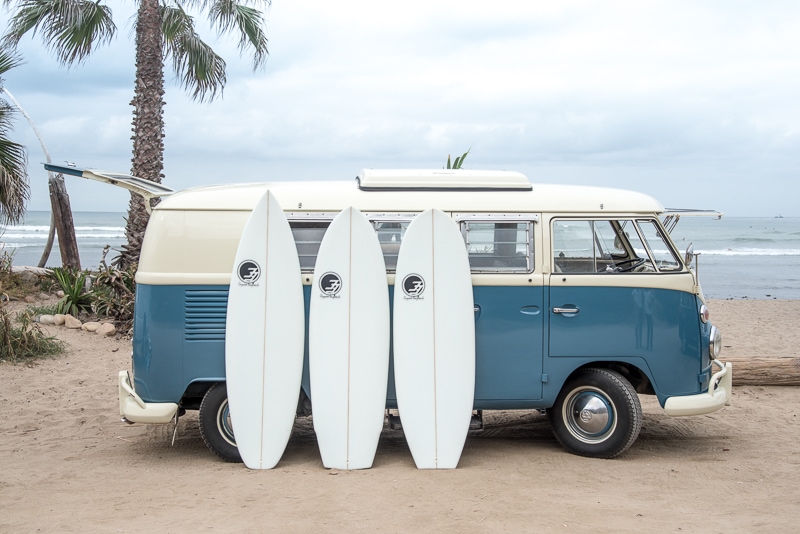
After you’re comfortable surfing funboards, the next step down is the shortboard surfboard.
As with funboards and longboards, not all shortboards are created equal. Some shortboards are specifically designed for really good punchy performance waves, while other shortboards are better suited as a daily driver and will perform in a wider variety of conditions and softer waves.
The first time you transition to a shortboard, you’ll definitely want to look for a board with a fuller outline that would fall into the daily driver or groveler type of category.
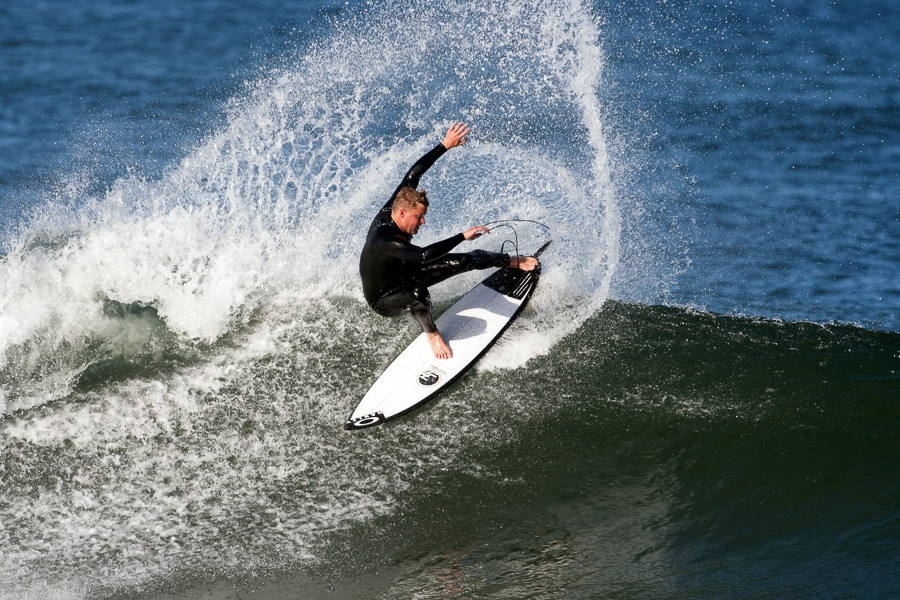
Your daily driver type of shortboard is typically a bit wider and thicker than a high-performance shortboard with a fuller nose and/or tail and a flatter rocker. These characteristics allow you to paddle them a bit better and get into waves much easier. They also handle fat and mushy sections of a wave more effectively, allowing you to keep your speed through the flats.
Recommended Beginner Shortboards:
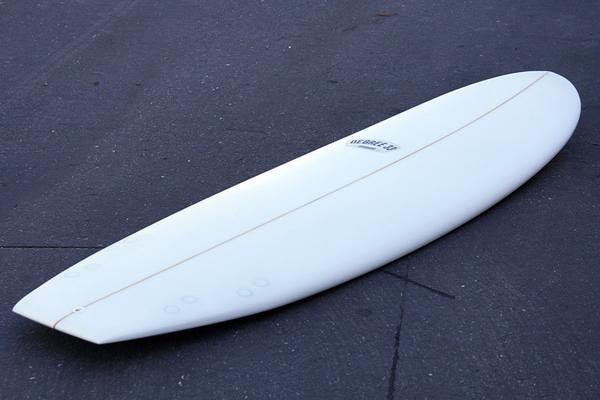
The Cloud / Performance Groveler
- Available 5’4” to 5’9” in a variety of colors and finishes
- Construction available: poly, soft top
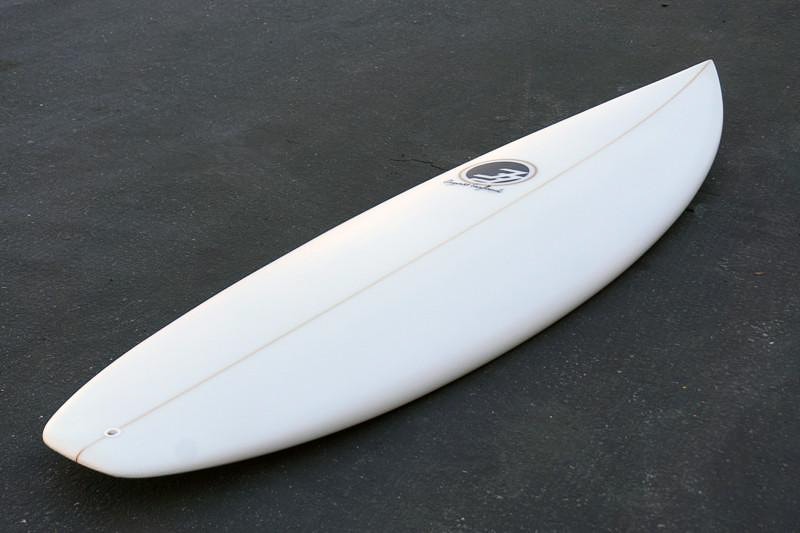
The All-Terrain Vehicle / Shortboard
- Available 5’10” to 6’4” in a variety of colors and finishes
- Construction available: poly, NexGen epoxy
Tips For Buying A Surfboard
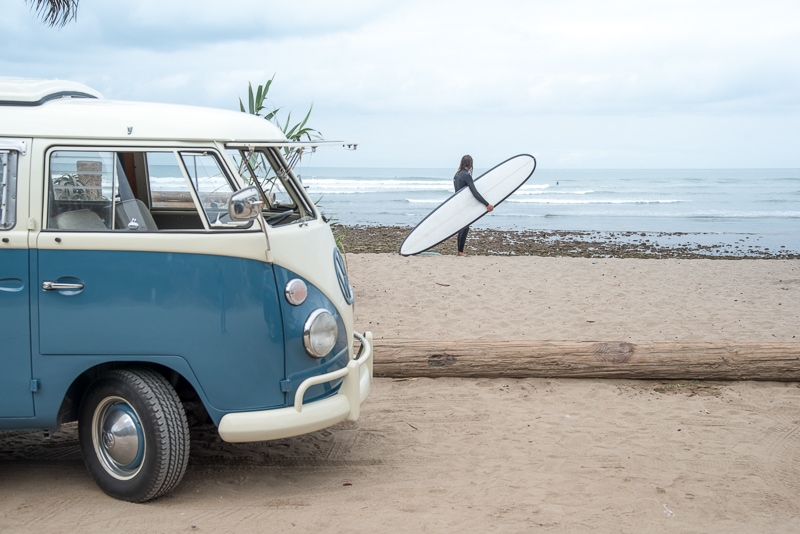
Buying your first surfboard might seem a bit complicated at times. You have one person telling you one thing and another saying something completely different. Here are a few tips from many years of buying surfboards to help you sort it all out.
- Don’t follow your friend’s advice. If you have a friend who grew up surfing and only rides shortboards, he or she might have a skewed perspective on how hard it is to learn to surf in adulthood versus as a kid and a bias toward shortboarding. “Get a shortboard,” they said, “you’ll be fine,” they said. Trust me, don’t do it.
- Find a board that is appropriate for your height and weight. If you’re a 6’0” 185-pound male, you’re probably going to want a slightly bigger board than a 5’7” 130-pound female for buoyancy and maneuverability purposes. Now when you get up into the longboard range and if this is your first surfboard, it’s not that big of a deal and either person could get by on the same 9’0″ longboard, but it’s always good to follow the shaper recommended dimensions for your height and weight when you’re just getting to know the ropes.
- Choose the right board for your ability. I know it’s tempting to want to dismiss all the information out there supporting learning how to surf on a longboard surfboard and just go straight to a shortboard if that’s what you ultimately want to ride. Just don’t do it. Grab yourself a longboard and focus on having fun while catching tons of waves and learning the fundamentals. You’ll be glad you did.
- Don’t overthink it. It’s always good to do your own research and due diligence, but at the same time, if you’re just starting out a great beginner surfboard would simply be a good all-around longboard like The Ultimate in the 8′ to 10′ range, depending on your height and weight.
- Try not to sell one surfboard to buy another if you don’t have to. As you progress from longboard to shortboard, you might consider selling your old surfboards as you progress. The funny thing is, once you get to your goal of riding a shortboard, you’ll probably find yourself wanting to ride a variety of surfboards depending on the conditions and to switch it up from time to time. Keeping each of your surfboard purchases as you expand your surfing horizons is a good way to start to build your surfboard quiver.
Beginner Surfboard FAQs
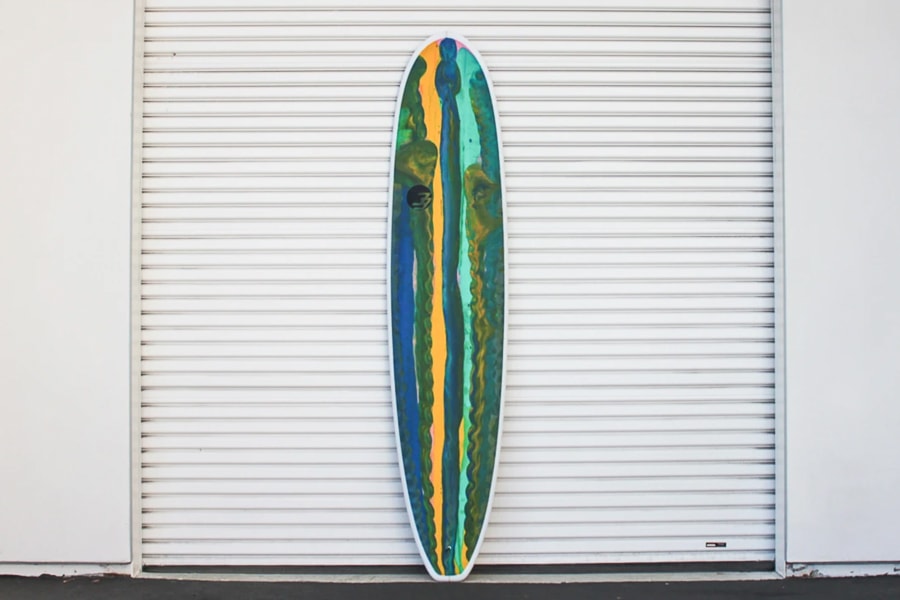
A good rule of thumb for beginner surfboards is to start with a longboard that is about 3 feet longer than your height. So if you’re 5’6” to 6’0” tall, an 8’6” to 9’0” longboard would be pretty ideal.
Generally speaking, an 8 to 9-foot surfboard is good for beginners. However, there are a couple of scenarios where a 7ft surfboard could be a good fit for you. First, if you’re super athletic and highly skilled at other board sports like wakeboarding or snowboarding, and your ultimate goal is to shortboard as soon as possible and you’re dedicated to surfing at least a couple of times a week, then, you might prefer a smaller 7ft surfboard to start. Second, if you’re in your teens, full of energy, and 130 lbs or less, and looking to work your way to a shortboard ASAP, then, a 7ft surfboard could be a good place to get your bearings.
Yes, longer surfboards are better for beginners for the following reasons:
– Long surfboards are more stable which helps when learning to balance
– Long surfboards are more buoyant which helps with paddling and catching waves
– It’s easier to catch waves so you’ll spend more time actually riding waves and less time bobbing around in the ocean waiting for a strong enough wave to catch.
– Long surfboards allow you to surf when it’s small which is ideal when learning
Foam surfboards are a great choice for beginners! For beginner surfers, an 8 to 9-foot foam longboard surfboard is one of the best options as an entry-level surfboard for a number of reasons. Foam surfboards are stable, user-friendly, and easy to paddle which makes catching waves and standing up a lot easier.
Also, you’re going to fall a lot when learning to surf so you’re likely to bump into your surfboard from time to time and a foam surfboard doesn’t hit as hard as a fiberglass surfboard.
Last but not least, another nice thing about foam surfboards is that you don’t really have to worry about dings, so you don’t have to be so careful when handling your precious cargo.
Shortboards are really not a great choice for an absolute beginner. If you really want to shortboard, it is still recommended to start on at least a funboard if not a longboard to nail the fundamentals before giving a shortboard a go. That said, many surfers (including myself) learned how to surf on shortboards, so while I wouldn’t recommend it, it is certainly possible. It’s just likely to be a longer and more difficult learning curve unless you are an innately gifted athlete or super grom.

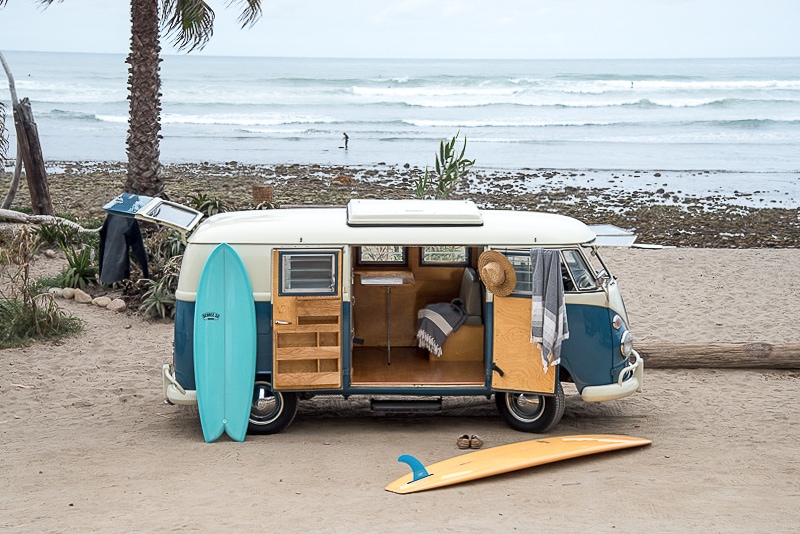
While the purpose of this article is to provide guidance on the progression of performance surfing and the ideal transition from a longboard surfboard to a shortboard surfboard, some people might just want to stick with longboarding their entire surfing life and can still progress from beginner level to advanced on a single board.
In this case, the lifelong longboarder might want to try out different types of longboards such as a performance longboard, a noserider, or a log to further progress their surfing and style.
That’s all folks, I hope you found this article to be helpful in one way or another on your quest to find the perfect beginner surfboards! And believe me, if you follow the simple longboard to funboard to shortboard approach to surfing progression, your road to ripping will be a lot shorter and more enjoyable along the way.
Thanks for reading, have fun out there, don’t take yourself too seriously, and we’ll see you in the water!
Questions, thoughts, or just want to say aloha?
Let us know in the comments below!
* This is a sponsored post in partnership with Degree 33 Surfboards and all words and opinions are my own. Thank you for supporting the brands that help keep Lush Palm going with fresh content and helpful guides.
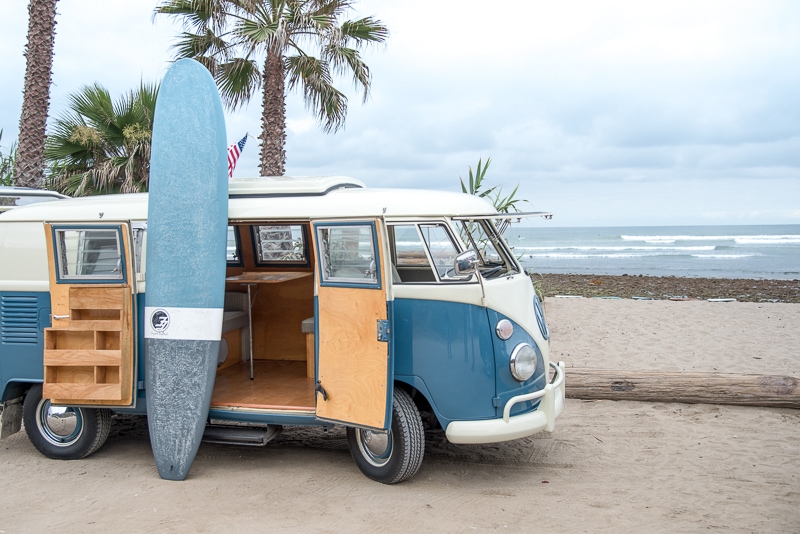



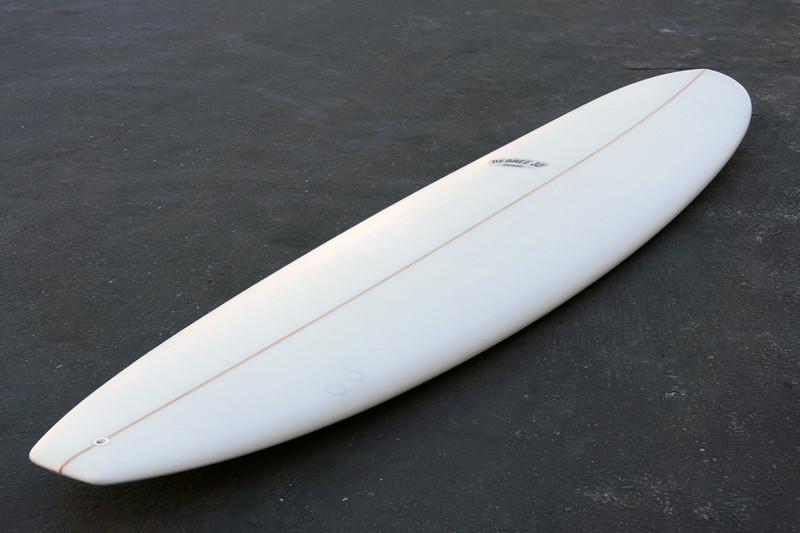
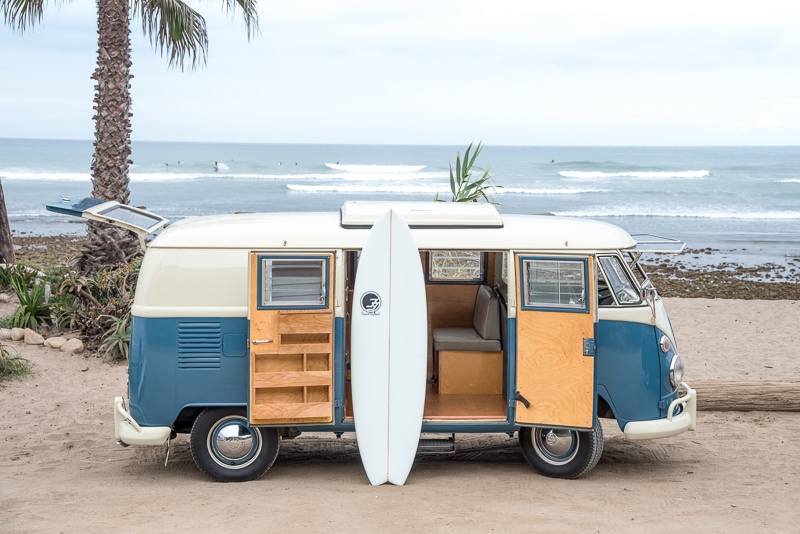
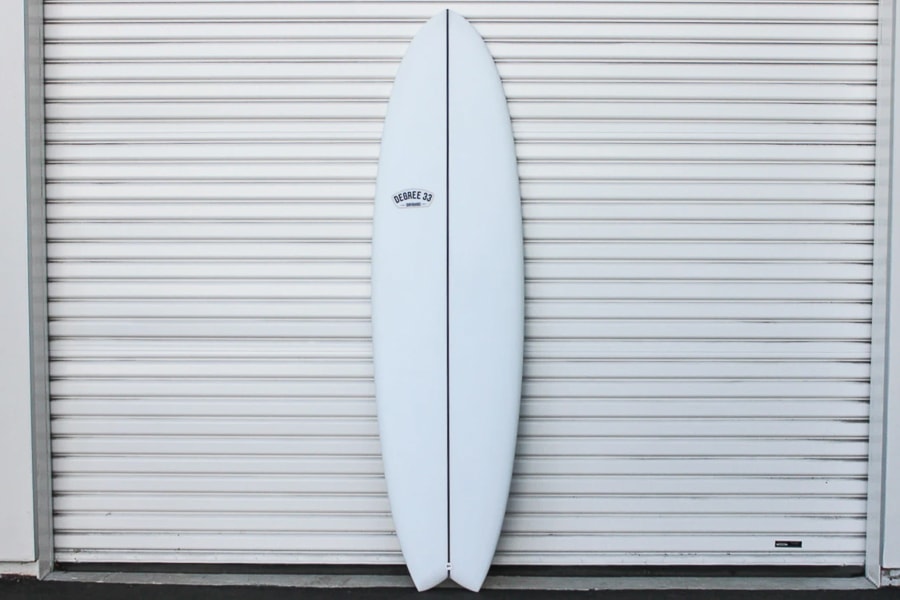
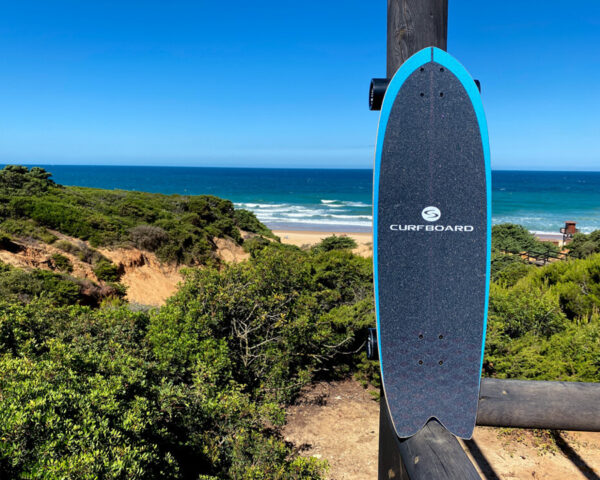
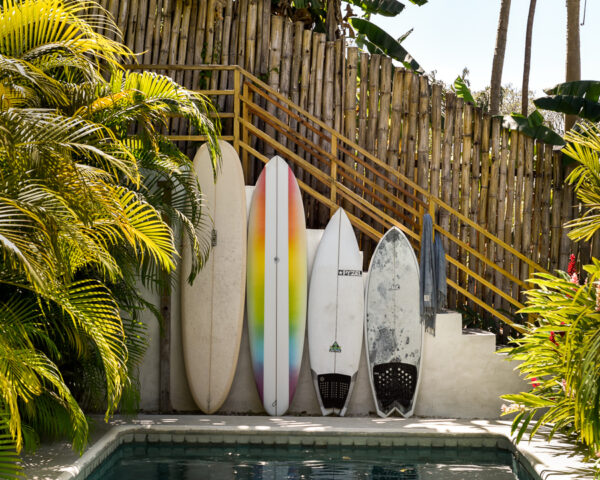
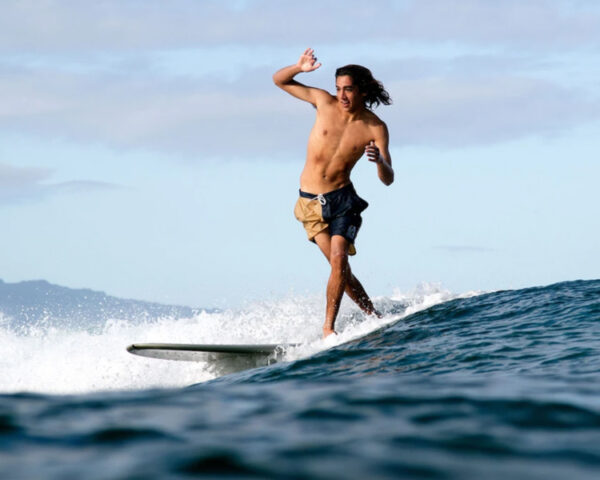

Thanks for this post – very informative! I’m wondering your thoughts on an 8′ foamboard for a 5’2″ and 120 lbs beginner?
Thanks!
Hey Josi, I think that would be a good length for you to start on. Enjoy!
Great blog post! This guide really helped me understand the basics of choosing a beginner surfboard. The clear explanations and recommendations make it much easier for someone like me who’s just starting out in the world of surfing.
I’d also like to suggest considering a good surfboard bag to protect the investment in a new board. A durable and well-padded bag can make a big difference in keeping the board safe from dings, scratches, and the elements. It’s like a cozy home for your surfboard when you’re not out catching waves. Keep up the good work.
Great, thanks! Definitely a good idea to get a good surfboard bag. Cheers
Thank you very helpful! Extremely informative!
You’re welcome, glad it helped you! Thanks for stopping by.
Good advice !
Thanks!
Great! It’s a really good writing. I think it will be helpful for beginners in surfing!
Great, great advice and a good read. I haven’t touched a board in over thirty years and your advice is primo. It’s high time I step back into the liquid. See ya out there !♀️
Happy you enjoyed it. Yes, time to get back out there! See you in the lineup!
This was great and very informative! My 14-year-old is just jumping into this world and this will totally help. We are renting now to get a feel for the right type, but saving this for when it’s time to buy.
Awesome! Thanks for letting us know, glad you found it to be helpful!
Great Article, Super Helpful with deciding what surfboards to consider.
Thanks Elliot — glad you found it helpful.
Hi, I’m a relatively decent “beginner” – I’ve been surfing at Skudin Surf in NJ for the past year or so and I’m very comfortable on the 9′ boards and currently working on the 8′. Are your 7’2″ soft top “Poacher” boards considered “foam”? That’s an important requirement. If so I’m thinking to get myself one and try to upgrade my skillset on it.
Anyway – great articles here, love this website!
Thanks,
Frank
Hey Frank, thanks for stopping by and for the nice feedback, glad you’re liking our website and content! Yea, the Hybrid Epoxy Softtop constructions like on the Poacher’s you’re referring to are kind of the best of both worlds; soft foam on top, but harder and more performance oriented than your typical soft top on the bottom, making for a foam soft top surfboard that rides more like a regular poly surfboard. Let us know if you have any other questions! Cheers
Many Thanks!! That’s perfect.
Frank
My pleasure! Enjoy!
Really appreciated this article. Very thorough and helpful as I’m just entering this surf world.
This summer, I bought a 7’6″ softboard for me (5’4″, 135lbs, athletic), my 8 yr old (90lbs, I’m guessing 4’4″), and my nearly 11 yr old (95lbs, 5′). We all love it and are all a bit greedy. My older son and I would love to move on from the softboard. Our only other experience is a 6 foot softboard my son actually preferred, and I thought was fun. So, I’m debating what would be suitable for both of us next. Not sure the best option is actually one board to share or we get our own. I’m a bit afraid to go bigger than 7’6″ because I think it would be difficult for him to manage in the water, not to mention practically, I know 7’6″ will fit in the car on a whim. So, I was thinking of a 7’6″ egg mini mal for me, something with plenty of volume. Maybe I’m being a bit cocky thinking that’ll work. But, not sure that’s the best option for my son? Any advice on what to move him onto to progress? We’re in the water a few times a week in the summer. I know it will slow down as school resumes but both keen to keep it up. Thanks.
Hi Amanda, sorry we missed your comment last August! I hope you were able to find the perfect board for your surf progression. What did you end up going with, and are you happy with what you decided on? Would love to hear your feedback. Cheers
Hi there! What would you recommend for a 5 year old who wants to learn? Is a long board too long for little groms?
Hello, I recently took my cousins children (ages 4 and 8) out for a surf lesson. They are very skilled snowboarders but had a hard time on boards smaller than 6 ft. I put them both on an 8’0 soft top, and that was the best experience for them. At 5, they are just playing around the white wash to start for a while, so the stability of a longer board is favorable. I’d suggest an 8’0 soft top, even for a little grom. Also, having an 8’0 soft top around the house is great because just about anybody can take it out and have fun on it. Enjoy!
Awesome article, and you are absolutely right about learning with the wrong board. That’s was exactly what happens to me. I was learning with a board I bought from a friend which was the wrong size and shape. I stop trying after few months. And I decided to windsurf in step. But learning how to surf was always in the back of my head. It was like unfinished business. Now 30 years later I’m going to give it a try again. Thanks, and definitely I will get one of those board you recommend in due time.
great article! I surfed in my 20s and 30s — by no means pro but had fun. I am now older (72), still fit, and want to start paddling again to see if I can at least get back to riding little fun waves. I am a small female (5’2″, 95lbs) and never had the weight to maneuver bigger boards or the wingspan to easily paddle a wide board. my favorites in my youth were 19″ widths. what would you suggest?
Hi Kathleen, that’s awesome and inspiring that you’re getting back out there, good for you! I understand that you’re on the smaller scale at 5’2″ 95lbs, so that a more narrow board might be preferred. In standard surfboards dimensions, you will have a hard time finding anything under 7’0 that is 19 inches wide. 19″ inches wide is even getting to the more narrow end of the scale for a shortboard nowadays. So I would suggest getting an 8’6 or 8’0 at the least. 50 years is a lot of time to take off and surfing is not quite like riding a bike so you’ll benefit from having a longer, wider, more stable surfboard, plus you’ll catch more waves and paddle easier. Surfers come in all sizes and there are lots of petite surfers out there who surf 9’0 – 10’0 longboards that are likely in the 21.5-23″ wide range. You should still be able to manage paddling boards that are around 21-22 inches wide no problems and maneuvering a longboard more has to do with technique and foot positioning than anything. A lot of surfers try to turn longboards with their shoulders and upper body, when it is more about your ability to use entire surface of the longboard, dropping your back foot back over the fin when making turns, walking to the nose to generate speed through flat sections, etc. Good luck getting back to it!
Hey, thanks for this – really helpful information! I had two questions:
1. My daughter and I want to start learning to surf together. She’ll be 10 soon and is about 4 and a half feet tall. Any suggestions for boards for her? Tips for learning together?
2. Besides the obvious pitfalls of anything used, anything leap to mind watch out for if we want to buy a used board? Is that just a bad idea?
Thanks!
Hi Joel, an 8’0 softtop surfboard is a pretty good place to start for most kids. Even at only 4 and a half feet tall, she will still tremendously benefit from the length and stability that an 8 foot surfboard provides as she learns to surf. And the soft top construction is nice so she doesn’t get banged up and intimidated by the board, poly/epoxy hard top boards can knock into your knees and ankles (and anywhere) as you’re learning which is never fun at any age. After some time on an 8’0, she might like a smaller surfboard like a 7’0 egg or something along those lines. Unless of course she has the longboard bug in her blood, in which case one might go longer than an 8’0 at that point. Buying a used board is not a bad idea if you know your way around surfboards. The used surfboard marketplace is full of people of all abilities who want to get rid of their surfboards for one reason or another, but if you don’t know what to look out for when assessing a board and if it’s a good board or not, you might end up with something that is not ideal for you or is in poor condition. Most people will tell you “ya this is a great board for you” as they just want to sell their board and don’t have your best interest in mind. Some things to look out for when buying used besides the obvious overall quality of the board include; dings that might have taken on water, signs of water damage, delamination, amount and degree of pressure dings, if the fin boxes and leash plugs are in good shape, any little cracks, etc. Cheers and good luck!
Hi Eric,
Thank you so much for your article, really helpful 🙂
Can you please advise me though – I’m a 5’7” 132lbs female. I’ve had a few lessons now, been going a few times on my own and I’m comfortable with a longboard but looking to get a funboard to suit more conditions and do turns etc. I want to get something long term that would last me a while. What would you recommend? Something forgiving but also suitable for the more experienced later down the line… fish? Egg? And what length should I be looking at?
Thank you, keep up the amazing work you’re doing
Hi Marty, thanks for the kind feedback. Happy to help, as usual, there is no right answer here, only what suits your own unique experience, journey, and preferences. That said, I’d suggest starting with an egg, then you can consider a fish down the road if you choose. But egg shape surfboards fit exactly what you’re describing, they go in a wide variety of conditions, you can turn them much easier than a longboard, but they are still plenty stable, user-friendly and forgiving. Check out the video about The Poacher. As for length, that’s where it gets a bit tricky when you’re in a transitional stage and looking for something longer term. Ideally, once you’re more experienced, someone your height and weight would likely want to ride this at around a 6’6″. But, since you’re still progressing, volume and length is very much your friend and will help you out a lot in the short term, so something like the 7’2″ would be better. So, this is where you’ve got to make a judgement call and think, do I want something that is more advanced and responsive, that will likely be a bit harder in the beginning as you adapt and advance your surf skills to being able to ride a shorter board, then go with the 6’6″. Or do you want something a bit more user friendly and stable, which will make it easier now (and you will still enjoy in the future), it just won’t be quite as progressive and maneuverable for you in the longer term. Then go with the 7’2″. Or you can split the difference and go with the 6’10”, right in-between. Personally, for longer term boards and more advanced surfers, I’m personally more of a fan of poly construction, but plenty of surfers like and prefer epoxy boards too. Decisions, decisions. 🙂 But now you’re more informed and have a bit to think about. Cheers and good luck
Should i add fins to my Softop Longboard if im a Beginner, would it make any difference?
Hey there, you should certainly use fins and in the case of soft top surfboards, most all (if not all) of them will come with some standard fins already intact. If your soft top has the option to swap out fins, I would still recommend using the standard default factory fins that come with the surfboard as changing up fins is not going to make much of a noticeable difference as a beginner. As you become more experienced, and upgrade to poly foam surfboards, perhaps get a single fin surfboard or whatever, then they template of fin that you use will start to make more of a difference, but in the beginning stages, just stick with the basics.
Hi Eric, thank you for this incredibly thoughtful and helpful article! I am new to surfing. I’ve don’t two lessons so far, spending some time practicing with both a 9ft and 8ft foamie. I plan to purchase a degree 33 ultimate with a soft top and epoxy bottom. I am 5’9” 136 lbs. I’m struggling to decide whether to get the 8’ or 9’. There is no 8’6” in the soft top. What would you recommend I go with? thanks!
Hi AJ, you’re welcome! Glad you found it helpful, that’s always great to hear 🙂 It depends, for your weight and height, you could go either way and be fine. I’d say it boils down to a couple of things; 1) what your gut tells about what you like better when taking out the 8ft or 9ft foamie you’re currently practicing on. Maybe you favor one over the other for some reason? Reflect on that for a minute. 2) Do you have bigger picture goals of longboarding or shortboarding? If longboarding, then the 9ft for sure. If shortboarding, then perhaps the 8ft since at your height and weight it will float you fine but will be a little more agile. If you’re unsure about these prompts, then go with the 9ft, you really can’t go wrong with the extra length and volume when beginning since it’s all about easy paddling and catching lots of waves. Good luck and enjoy the process!
Hi, I found this article to be one of the most helpful out there. I am totally brand new at surfing but I’ve had a couple of lessons. I eventually want to become a longboarder. I am 6’1″ and 145 pounds. Should I go with a 9’0″ foamie or something a little longer? Also I don’t have very much to spend on a board, is there any tips you have for finding a cheap board that is good enough to ride. I’ve been told used boards can be cheap but as a beginner to stay away from most used boards.
Hey Forrest, thanks for stopping by. There’s nothing wrong with used surfboards that you might find on classified forums, just be sure to inspect the board for sneaky cracks and dings. You want to stay away from boards that have been dinged and poorly repaired, and might have taken on water. So if you have someone who is knowledgable about what to look for, enroll them for some help in your search. Regarding size, for your height and goals to become a longboarder, I would suggest you look at boards no shorter than 9’6″ if possible. But anything between 9’6″ and 10′ would be nice length for you as that is likely the direction you would go as you progress your longboarding skills like cross-stepping and noseriding.
Hi there, thanks for this article.
I’m 6’5 and about 160 pounds. Should I go with a 9′ or 9’6″ epoxy ultimate?
Hey Mike, either would work great, but go with the 9’6″ since you’re pretty tall. Cheers
This is by far one of the best articles I’ve found about beginning to surf. Love it, and have saved it to refer to as I (hopefully!) progress 🙂
Awesome, thanks for your feedback Iona! So happy we can help on your surfing journey 🙂
Thank you so much for sharing all these!
I am going to get my first surfboard this coming week – debating between the soft-top (9 ft) and an epoxy board. I have read a lot about these two but still not sure which one to get and all my friend seems to have different opinions (strong opinions too) on which one is better…Would love to hear your thoughts!
A bit of information about my surfing journey – been taking surfing lessons and good with pop-up, but only been on foamies so far. I personally love how light epoxy is! but never had any experience with it. I wanted something that could potentially be fun in a long run as well, and I am located in Maui, HI.
Hi Rachel, soft tops are nice when starting out because they don’t bang you up as much in the surf when you wipeout (often!). Epoxy surfboards on the other hand will hit much harder but are definitely among the most durable of materials so tend to have solid longevity. As for surfboard materials in general, ask 5 people what they prefer and what’s best and you’ll get 5 different answers. Beginners to pros ride everything from soft tops, to traditional PU foam boards, to epoxy boards and more and every person might like something for different reasons. I’d say try out an epoxy board if you can before you buy it since you already have experience on foam surfboards. Then you can compare and decide what you like the feel of best to start. And with surfing, you preferences may evolve and change over the years. So perhaps you get a soft top or expoxy now and then in a year or two you might want to try a slightly different size or shape or material since you will have more experience to draw on at that point. Enjoy!
Thanks very much for the beginner size guide – very useful!
You’re welcome! Glad you found it to be very useful. Cheers
Thanks so much for all the info, this was a very informative article. I’m a male thats 5’2″ around 140lbs and was thinking of trying surfing. I read your 3′ rule, but would a 8′ long board be a good go to for a started board for my weight and height?
You’re welcome, happy to help. Yeah, an 8’0 surfboard would work well for your height and weight to start. But an 8’6 would be great too if you want a little extra buoyancy and stability. It also depends on your goals though, if you ultimately plan to be a longboarder, then you can go even longer, 9’0 to 9’6 to get used to handling longer boards and for noseriding, etc. But for starting out, and learning, right in that approximate 3 foot longer your height range is typically a pretty good general rule of thumb.
Hi Eric and Tara,
I’m new to surfing. Have done a bit of different board sports before. I’m 5.9ft /172lbs and was thinking about getting a 8ft softy. Am I gonna be fine on that? Or should I be looking for a longer board?
Great job guys. Appreciate your article!
Hi Marty, yeah, 8ft foam surfboards are a good starting point for many people of various heights and weights. So you’d totally be fine on it, that said, an 8’6 to 9’0 would be even more ideal if you’re looking for the optimal starter length. But don’t sweat it, you’ll be good either way.
Thank you so much! I’ve been looking for a while and this is really helpful.
Awesome, Jamie! We’re stoked it was helpful for you. Cheers
Hi Eric:
Great article as I am 100% new to this. I have an opportunity to purchase a used/ new 9’6 epoxy board for 700 bucks with proven shape fin. Not even sure what that means for fins lol.. anyway my goals are just to learn and ride waves. I was an avid wakeboarder and skate boarder years ago but like 20 years ago haha. Now for the bad… I am 46 now and have suffered some injuries the last 8 years due to my job. I have had 3 back surgeries that resulted in having drop foot on my right foot but have about 50% use of it still. I have never surfed but just relocated to the eastern shore and have always wanted to learn. I believe I would have done well years ago and I hope to at least figure this out good enough to have a leisure day out playing in the water. I am 6’2 and 195 lbs and still relatively active minus the goofy foot. Does this board sound reasonable for me to start with and in that price range ? Thanks so much! Forgot one detail…. The same gentleman has a new/used 8’0 epoxy for 500$ also.
Hi Jimmy, glad that you found it to be helpful! Thanks for sharing your story and sorry about those injuries, I hope you’re able to get in the water for some good ol’ fashioned ocean therapy, surfing is an incredible hobby… So, regarding surfboard size, yeah, 9’6″ would be a good place to start for a guy your size. Regarding price range, that’s all relative to your finances. Everyone has different levels of comfort with spending. I’d say if you like the board and it doesn’t break the bank, then go for it. It’ll stay in good shape so long as you take care of it for a very long time. Enjoy your journey! Oh yeah, I’d say the 8’0″ is a bit small for you to be starting out on. Stick with a 9’6″ for sure!
Hey, this was very helpful! Really appreciated your expert advice in a relatively short tutorial.
I just finished up with my third surfing lesson–with the Seth Broudy school in Virginia Beach–in about 5 years. I’ve been out twice with Seth Broudy’s folks, and took a lesson some years back at Pacific Beach in San Diego.
My dad raised me bodysurfing on the Jersey Shore, and that experience–as well as being a fairly versatile athlete–has helped me do very well in these lessons. I got up for a majority of the waves the instructors positioned me in, and I believe now I know when to pop up, where to position myself, and even angle the board to ride the wave longer during runs.
Assateague, just south of Ocean City, MD, is one spot a lot of surfers enjoy. And on the way is the East of Maui shop in Annapolis, MD, that rents boards. I believe the boards they have are from Bic, and I’m pretty sure they’re soft tops. I thought I’d rent a board maybe a couple of times, then…
…That’s where you come in. I’m a spry, 56-year old who has always wanted to have a board of my own. If I purchase, I know I would want a long board, and I’m about 5’7″, between 172-175 pounds, depending on the week (and my appetite).
This could be my one and only board that I enjoy, and hopefully someday train my daughter on. And, I don’t mind spending a little more on it. I work with REI as a hiking boot specialist, and I’m constantly coaching customers to buy a boot that’s comfortable and secure on the foot…what it looks like is secondary (or, as I’m known to say…”Fashion doesn’t get you up the mountain”). At the same time, it’s also nice to get them a boot that they find appealing to the sight as well.
I’d like to do the same for a board. First and foremost would be for it to be somewhat forgiving, catered to my height and weight, and yes…I’d love to get something that’s visually appealing.
Any advice as to the length, soft top or not, and specific boards I should be looking at?
Thanks so much!
Hey Doug, thanks for your thoughtful comment. I’d be happy to share my advice and a specific surfboard recommendation and a little background as to the “why” behind it. So, here we go…
For many beginner surfers, a soft top or an epoxy longboard is a great first surfboard. Soft tops are nice because they don’t bang you up as much in the waves when you’re still learning and typically wiping out often and getting knock around by your board. It’s always much nicer to take a soft top to the shins, body, or head rather than a hard surfboard. Epoxy surfboards are known to be a bit lighter and more durable than a standard poly surfboard. You’ll find nearly all beginner surfboards available to rent at surf camps or provider by surf instructors are either soft top or epoxy for these reasons.
That said, while everyone has their own personal preferences and surfers of all levels ride all types and contractions of surfboards from soft tops, to epoxy, to poly, I tend to prefer traditional Poly foam surfboards because I like the way they feel in comparison to an Epoxy surfboard. Poly boards are typically known to have more flex and sit in the water a little deeper. To me, it just feels more natural and slightly less buoyant and “poppy” for lack of a better description. I also think that aesthetically speaking Poly surfboards are more pleasing to my eye as they look more natural and hand-shaped (since they typically are) rather than being machine manufactured and painted. I think poly surfboards (while more prone to getting dings) age more gracefully as well. So, that’s just my two cents on the topic.
For your height and weight and keeping in mind you want to teach your daughter on this surfboard in the future, I suggest an 8’6″ or 9’0 – The Ultimate Poly longboard, the 8’6 if you want a little more maneuverability, and the 9’0 if you want more stability and volume to more easily catch waves. It’s a super versatile all around longboard and a great surfboard if you don’t plan on expanding your quiver. There are a variety of designs available from resin-tinted colors, to classic white foam with dark-wood stringers, and even a couple with cool cloth inlays.
I hope you find the perfect surfboard and absolutely love it! Cheers and enjoy!
I’m 6’1 180, I was thinking of getting a 9′, will that size be fine for me? Thank you for the article, very helpful .
Hey, yeah, a 9 footer would be a great surfboard size for you. You’re welcome, glad you found it to be helpful!
Hey Eric, man am I glad I ran across your article. Quick synopsis: we just moved to Pensacola, Florida this past month from north Louisiana. Been to the beach seems like every weekend. Went out yesterday. The day before tropical storm Fred was suppose to hit. Watching folks out on their boards got me wanting to be out with em. So here I am doing the research. Now I feel much more informed and know exactly where to start.
Thanks again.
You’re welcome, Ricky! Thanks for letting me know, much appreciated! Enjoy the learning process
Hey Eric,
Thanks for the informative article. If you have time to answer a question — I started last summer with a few lessons off the New Jersey Shore on a 9 foot foam board (I am 5’11 and about 160 lbs) and it was definitely slow going. This summer I went for another couple lessons on a 9 foot board and it got a little better. Teacher recommended I start going out on my own to get a feel for it all. Last Friday, the shop I go to could only rent me a 7’10” hardboard and I actually had more success than I expected on it. Maybe it was the waves, my energy levels that day, but I was pleasantly surprised. I still consider myself a beginner but — would you rec buying a 9 footer (as I was planning on) or should I come down a bit?
Thanks so much — Chris.
Hey Chris, you’re welcome — glad you find it to be helpful! You’re right, there are a lot of variables that go into having a great session versus a not so great one, and this will continue throughout the life of your surfing days, unfortunately, haha. While they say there are no bad days spent in the water (and I totally agree!), there are days when you’re just off or something else is off and that is just how it goes. Anyways, that’s another discussion I suppose. So, back to your question. Everyone is different, and while the majority of the time I’d recommend a brand new beginner start on longer board like a 9’0, that is not always necessary. For 5’11” and 160 lbs, a 7’10 is plenty of board if you’re fit and athletic. So, in your case, if you had a session that was as good or better on a smaller board, then maybe that would be fine for you. Some people prefer a little less foam and that’s okay. It’s all about catching waves and staying motivated to get out there. So if a slightly smaller board works for you, then so be it. Perhaps, an 8’0 would be a good starting point for you if you felt comfortable on the 7’10 but feel that having a little more foam and stability could be helpful. Actually, if you felt good on the 7’10”, then anything in the 7’10 to 8’6 range with a full eggy longboard outline would probably be a good starting point. Let us know what you end up going with and how it goes once you’ve had a chance to surf it a bit. Good luck!
Hi,
I understand the notion of volume for stability. I am a beginner and have rented a few boards already. I rented my longest today at 8’2″ (NSP P2 I believe) and it was the best experience so far, except for 1 thing, I could not swim properly. I am a narrow woman (narrow shoulders) and only part of my forearm made it into the water.
I am looking around the web for soft tops of at least 8’2″, but 21 or less in width. I am not finding anything. I was thinking I could get the same volume by going longer 8’6″. I believe the board I had was 66L.
I am not finding longboards as thin as the mid-length I am used to. Do I have to stick to mid-lenght just because I have narrow shoulders or can I get myself one of those better longboards.
Any model to recommend for my situation? I am tall enough 5’7, just not very wide.
Thank you so much for taking the time and effort to write such an interesting and informative article. I really enjoyed and have lots of excellent take aways to help me purchase the right kind of board for me. Very best wishes…
You’re very much welcome, Ian! Thanks for taking the time and effort to let me know! I really appreciate it and find it super motivating to keep creating more content like this. Thanks for stopping by. Cheers
This is the article I wish I read when I was 15. So so good! I would love a board recommendation from you! I have been riding an epoxy 7’6 fun board for almost 16 years. I would say I’m back at the beginner stage since taking 2 years off to have a kid, and live in Charleston, South Carolina where we have smaller waves with a few exceptions sporadically through out the year. Do you have any recommendations of a good board to look into next? Thank you! Your whole blog and site is amazing.
Thanks so much for the feedback, Krista! I wish I had read it too, but I was stubborn, so I probably would have wrote it off and picked up another shortboard that was too small and not ideal anyway, haha. It all really depends where you want to take your surfing, how often you go and, the type of waves you most often find yourself in. You provided some good insight on that front. So, if you don’t surf too consistently and feel you are back at the beginner stages, then I would recommend getting a board with plenty of foam so you can catch boat loads of waves and keep your stoke high when you have the chance to get in the water. That said, if you want to go a little smaller but still get lots of waves, maybe like a 7’0″ eggy funboard would do (see The Poacher / Mid-length Funboard above). Or, something a little more progressive like a similar length hybrid fish could be fun for you (see Easy Rider / Hybrid Fish above). That all said, if you only go a couple of times a year when it’s small, you’d probably find you are able to get the most waves on longboard (see The Ultimate). Hope this helps to point you in the right direction! Let me know if you have any other questions and I’ll be happy to help. Enjoy!
I found this article to be incredibly helpful and inspiring. I’m in my 40’s trying to learn to surf and instead of discouraging me, I feel ready to go now. Thank you.
Thanks for the feedback, glad you are feeling encouraged. Surfing takes a good amount of time and patience to learn, but if you’re determined and dedicated, you can do it at any age! Enjoy the process.
I’m a complete novice – so thank you! Such a great simply explained article I can use to help my 4 kiddies!
Hey Daniel, thanks for sharing your feedback on the article! Glad you like it and found it helpful! Good luck with your journey into the wonderful world of surfing.
Thanks for the article. You made it sound nice and simple and I feel I have a good handle on what to go out and look for now. -Shaun
Awesome, Shaun. Happy you found it helpful! ✌
Hey!
I have been rocking the classic 8′ costco special Wavestorm board for awhile now. I feel confident on it and can even do head stands. I felt ready to drop down to a funboard and scored a good deal on a 6’10” board. It’s a poly board and pretty narrow and unfortunately not as buoyant as I had hoped. And oh my does it feel tiny.
I took it out this morning for the first time to practice paddling and balancing on it. I can sink the whole board (I’m 5′ even and 140lbs athletic build). This tells me it’s definitely not a funboard. I did catch a few waves and stood up on a good one. I guess my question is should it feel pretty difficult to make that jump? Should I keep at it? Or should I bit the bullet and get something more buoyant now?
I was trying to avoid dropping too much money so took what came up on FB marketplace that was in a funboard length. Learned my lesson about buoyancy pretty quickly…
Cheers,
Michaela
Hey Michaela, thanks for the great comment and details! If it’s a 6’10 poly surfboard and is more of a shortboard shape/template, that being one that is more narrow in the nose and tail as you described, then, unfortunately, it is probably not a great transitional board for you. Could you tough it out and try to adapt and potentially get away with learning on it instead of getting a better-suited board? Probably, but that probably wouldn’t be ideal. For a funboard shape, you want a surfboard with more volume, less rocker, and a wider overall template (especially in the nose) so you don’t sacrifice paddle ability and you still catch loads of waves. That’s how you will progress the fastest, by having lots of fun and catching as many waves as possible! I’d suggest something like The Poacher. If you decide to go that route, you might be able to recover some money by selling your other board. Cheers and good luck!
Oh Man…. your story is much like mine. I was a super athletic year-round soccer player and roller skated and rode skateboards too. I took to surfing cause most of my soccer buddies did. I was 5′ 7″ at age 14 and got my first board. It was a 5′ 10″ Ocean Avenue Thruster. I was SOOO excited… IT TOOK FOREVER TO LEARN HOW TO SURF! I didn’t know squat. Just last summer, me and the family went to Myrtle Beach and my 14 year old (gymnast/soccer player) wanted to learn to surf… We rented an 8ft foam board for the week. First day out, there were 1ft to 1.5 ft mush waves rolling in. I was out there giving her a push… She totally got up and stood easily 10-12 times that day and even rode just a little bit of face. It was sooooo incredibly fun to watch her… Even adults on the beach were excited to see her stand…. All that to say – I LOVE THIS WRITE UP!!!!
Hello I have been surfing for one year on a foamy surf board I was wondering when I will be able to change it to a shorter board I am surfing on 8 6′ 90 liter foamy board and I want to make a transfer to dura tech 7 6′ 62 liter last question is 7 6′ 62 litre board better than 7 9′ 58 litre board
Hey Ahmed, all good questions. Regarding when you will be able to go from a longer surfboard to a shorter surfboard, that just all depends on how fast you are progressing and when you feel ready to make the switch. For a lot of adult surfers, 1 year is probably about the right time to progress down to a smaller board if that is your goal, although some people may not need that long and others might need longer. Regarding the specific boards you mentioned, I’m not familiar with them but if they are the same shape (e.g. an egg or mini-mal shape) it won’t be that big of a difference for you either way. I’d just go with the smaller 7’6″ though if your ultimate goal is to go to a shortboard because it will be just a bit more agile than the 7’9″ but still should offer you plenty of foam and paddle ability. Good luck! Cheers
Maraming salamat po dami ko natutunan at sana makapag surf nako…baguhan lang po ako…
Walang anuman. Tumatagal upang malaman upang mag-surf ngunit ito ay isa sa mga pinaka nakakatuwang bagay sa mundo.
Hey, this was super helpful! I liked how you broke down the basics so I could help narrow my search. Do you have some tips on wetsuits or any other necessities for beginners? Also, could you add some pointers for surfing etiquette to be good to your fellow surfer once I get out there?
Hey Chris,
Thanks for your feedback — we’re stoked you found it helpful! We have a couple of wetsuit guides to help find the best suit: Men’s Wetsuit Guide & Women’s Wetsuit Guide. Other than a wetsuit in cold water, you’ll just need a surfboard leash, fins, and wax, and you should be good to go.
And good on you for thinking about surf etiquette, as it’s one of the most important things in surfing. We have some projects in the works about surf etiquette and beginner surf tips, so stay tuned. Cheers!
Eric
Thank You for breaking down all boards deference
You gave me hope so I can learn surfing on my new 7’ softboard
I want to be on short board in my life
Thank You
Greg
You’re welcome, Greg! Thanks for sharing, surf often, and stick with it and you’ll get there. Cheers
Eric,
Thanks for the article.
It was quite informative to a guy who might have spent a total of 10 hours on any board (skate, wake, etc.) his whole life.
I’m more of an intellectual (I use that word very loosely) when it comes to new pursuits, and researching surfing and the plethora of boards that are available was very nicely broken down in your article.
Daniel
Hey Daniel, my pleasure, thanks for your feedback! Glad you found the article to be helpful. Cheers
Awesome tips, thanks for such a concise, easy to follow article! I think I need to downsize to a funboard soon 🙂
Thanks for your feedback, Amber! We’re stoked you found it helpful.
Need some help. New in N. Orange County. Looking for a used 8-9′ foam board for young teen grand children, where to go. They were everywhere on Maui, not here though. Please help. Thanks. Oh, great article. It fits perfect for all levels even a 75 yr old like me. Ride a 9’6′ Robert August Nose Rider – shaped by Robert himself many years ago.
Hi Dave – A lot of surf shops in California only sell new foam boards — I’m guessing the reason being that used foam boards can get pretty banged up and also have a relatively low resale value. Your best bet for finding a used soft top surfboard is via an online classifieds site like Craigslist or OfferUp. Another thought is to contact a shop that rents out surfboards or a surf school as they might sell some of their older foam boards. Good luck!
P.S. Your Robert August Nose Rider sounds rad 🙂
Thank you for the fantastically well written article. It helped me understand a lot about the different surfboards and my needs when it comes to learning the sport. I can’t wait to put your tips into practice!
Awesome, Juliana! So happy we could help. Have a great time out there!
Eric,
Thanks again for shairing your knowledge today and tips for surfing in Encinitas to old guy from Midwest. That was kind of you and much appreciated!
Bob
Hey Bob, pleasure chatting with you. Hope you have an amazing rest of your trip!
I’ll email a couple other tips and resources in case you don’t get a notice of this response.
Cheers